Global high-mix volume high-speed PCBA manufacturer
9:00 -18:00, Mon. - Fri. (GMT+8)
9:00 -12:00, Sat. (GMT+8)
(Except Chinese public holidays)
Global high-mix volume high-speed PCBA manufacturer
9:00 -18:00, Mon. - Fri. (GMT+8)
9:00 -12:00, Sat. (GMT+8)
(Except Chinese public holidays)
HomePage > Blog > Knowledge Base > A Complete Guide to PCBA Test Fixtures
Against the backdrop of the rapid development of the electronic manufacturing industry, ensuring product quality is a prerequisite for production. Each inspection of products before they leave the factory directly affects the final quality and customer satisfaction. For enterprises, maintaining testing accuracy in mass production and reducing the unstable factors brought about by manual operations have become important indicators of competitiveness. Especially when conducting PCBA testing, the stability, efficiency and consistency of the testing process often determine the yield rate and delivery speed.
During the production process, the quality of PCBA test fixture design, custom test fixtures and PCBA test fixture kits will directly affect the speed and accuracy of the test. High-quality design not only meets various testing requirements but also enables rapid adjustment during product upgrades or batch changes, ensuring the continuous operation and stable performance of the test line.
This article will provide a comprehensive introduction to PCBA test fixtures, including their definition, structural composition, advantages and disadvantages, common types, compatibility with test systems, and design highlights. Meanwhile, this article also introduces you to how a well-designed PCBA test fixture can make the PCBA testing process faster, more stable, and significantly improve production efficiency.
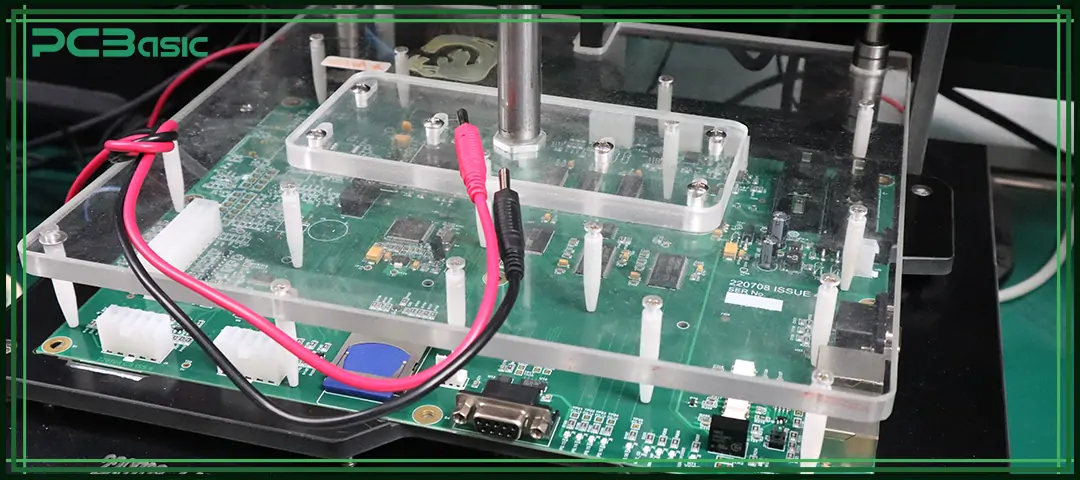
The PCBA test fixture is a commonly used mechanical device in production testing, which is used to precisely position and firmly fix the printed circuit board (PCB) at the test position, and at the same time, establish stable and reliable electrical contact with the test points on the circuit board through probes. Its main function is to enable PCBA testing to be carried out without the need for manual point-by-point probing, thereby reducing human errors, improving detection accuracy, and significantly shortening the testing time.
In the practical application of PCBA test fixtures, such fixtures are usually used in conjunction with ICT (in-circuit testing) systems and FCT (functional testing) workstations, or custom test fixtures can also be developed according to the characteristics of the products. For example, when using functional test fixtures, the circuit board will be powered on and run just like in a real working environment. By detecting parameters such as input and output signals, voltage, and current, it is confirmed whether all functions are normal.
When using PCBA test fixtures for production inspection, engineers can quickly complete automated tests, collect and analyze data in real time, determine whether the circuit boards are qualified, and at the same time avoid the risk of damage caused by frequent manual contact. This approach not only enhances the testing efficiency but also ensures the stability and consistency of the test results, making it highly suitable for the PCBA testing scenarios in mass production.
A complete set of PCBA test fixtures is usually composed of the following key parts, each of which plays an important role in PCBA testing:
This is the main structural body of the entire fixture, generally made of aluminum, steel or high-strength plastic. It can not only withstand the mechanical pressure during long-term use, but also maintain stability during the testing process. The base provides a solid support for the fixture, while the frame fixes the positions of each component, ensuring that the testing process does not go wrong due to vibration or displacement.
The circuit board test fixture realizes the transmission of electrical signals by contacting the test points or pads on the PCB through pogo pins or spring-loaded probes. For custom test fixtures, the arrangement of the pins is precisely designed according to the specific layout of the customer's circuit board and the test requirements to ensure that each test point can be stably contacted.
The actuation system is responsible for pressing the PCB tightly onto the probes during testing to ensure stable contact. Different PCBA test fixture kits will be equipped with different actuation methods:
Manual lever: Suitable for small-batch testing, with low cost and simple structure.
Pneumatic press: Driven by compressed air, it is suitable for high-speed mass production, labor-saving and highly efficient.
Vacuum hold-down: It fixes the PCB by vacuum negative pressure and is suitable for testing fine-pitch, double-sided PCBs or those with high requirements for the flatness of the board surface.
High-quality wiring connects the probe to the PCBA tester or functional testing equipment, ensuring stable and reliable signal transmission. For tests that are sensitive to signal interference, shielded cables are usually used to reduce the influence of external noise.
Some functional test fixtures are equipped with electronic modules such as microcontrollers, relays, and signal switching boards, which are used to control the testing process, for example, automatically switching test modes, power supply control, and performing firmware burning functions.
In the PCBA testing lines, safety design is very important. Anti-static (ESD) protection is often added to fixtures to prevent static electricity from damaging components, a safety interlock device to prevent misoperation, and operator safety shields to protect the personal safety of staff during high-speed or high-voltage testing processes.
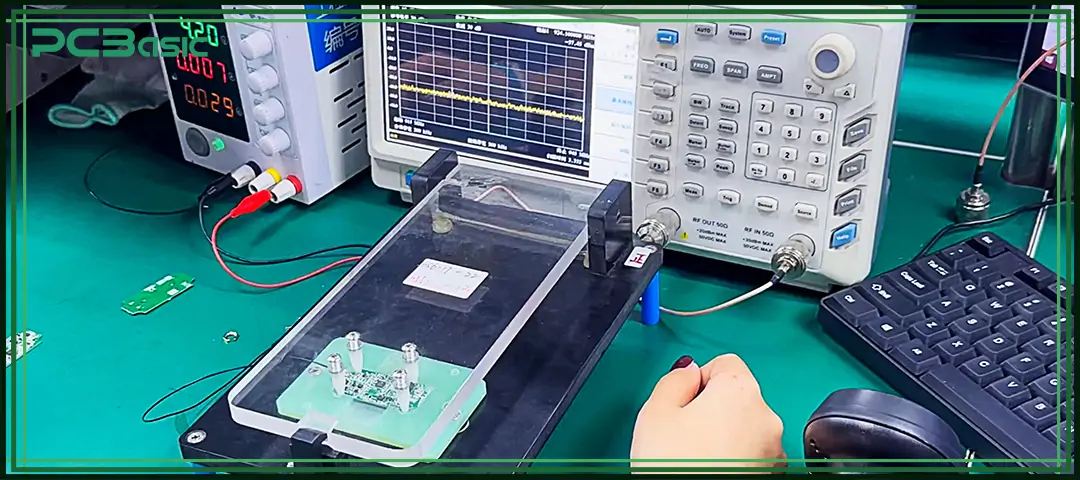
To complete testing quickly and accurately in mass production, PCBA manufacturers usually use various types of PCBA test fixtures. From functional testing to in-circuit testing, from burn-in testing to programming fixtures, different types of fixtures can meet various testing requirements, helping to enhance production efficiency and reduce defect rates.
The functional test fixture can simulate the actual working environment of the product, allowing the PCBA tester to power the circuit board and run the same functional program as the finished product. By detecting parameters such as voltage, current, and signal input/output, it is possible to comprehensively verify whether the performance of the circuit board meets the design requirements. This testing method is often used to confirm whether the overall machine function is normal.
The circuit board test fixture for ICT can simultaneously connect multiple test points on the circuit board to detect short circuits, open circuits, resistors, capacitors, and whether the installation positions of components are correct without a power supply. It can quickly detect soldering defects or component errors during the assembly process, helping to identify production issues at an early stage and reducing subsequent rework costs.
This kind of custom test fixtures is specifically designed for stress testing and will run the circuit board for a long time under extreme conditions, such as high temperature and high voltage, to simulate the long-term usage environment of the product. In this way, faults that are prone to occur during early use can be exposed in advance, thereby enhancing the stability and reliability of the product.
PCBA test fixtures can also be used as programming fixtures to load firmware, programs or configuration data into microcontrollers, memory chips and other programmable devices during the production process. This type of fixture is usually equipped with quick interfaces and stable contact structures to ensure efficient and stable burning results in mass production.
These PCBA test fixture kits firmly fix the circuit board at the test position by pneumatic pressure or vacuum suction, ensuring stable contact between the probes and the test points. Pneumatic fixtures are suitable for high-speed large-scale production, while vacuum fixtures are particularly suitable for testing high-density PCBs or double-sided boards, and can avoid board surface deformation caused by mechanical pressure.
The manually operated custom test fixtures have a simple structure and low cost, and are suitable for use in the prototype development stage or small-batch production. The operator can complete the contact by manual pressing, which is highly flexible, but it is not suitable for large-scale continuous production.
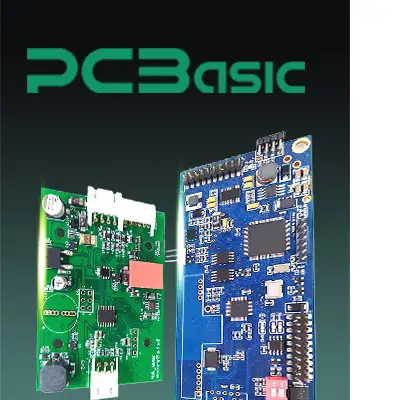
Time is money in your projects – and PCBasic gets it. PCBasic is a PCB assembly company that delivers fast, flawless results every time. Our comprehensive PCB assembly services include expert engineering support at every step, ensuring top quality in every board. As a leading PCB assembly manufacturer, we provide a one-stop solution that streamlines your supply chain. Partner with our advanced PCB prototype factory for quick turnarounds and superior results you can trust.
|
Category |
Item |
Description |
|
Advantages |
Repeatability |
Every time the PCBA tester is used, it delivers consistent and stable results. |
|
Speed |
Compared to manual probing, PCBA testing time is greatly reduced, improving testing efficiency. |
|
|
Scalability |
Custom test fixtures can be directly used in mass production with minimal setup and adjustment time. |
|
|
Protection |
Effectively reduces the risk of damage to PCBs during handling and contact. |
|
|
Customization |
PCBA test fixture kits can be designed to match the shape, size, and testing requirements of different products. |
|
|
Disadvantages |
Initial Cost |
High-quality custom test fixtures require significant upfront investment. |
|
Design Time |
Complex PCBA test fixture designs require a longer development cycle. |
|
|
Inflexibility |
A fixture designed for a specific board may not be adaptable to other models unless modular in design. |
|
|
Maintenance |
Probe tips and mechanical components require regular cleaning and replacement to ensure testing accuracy and stability. |
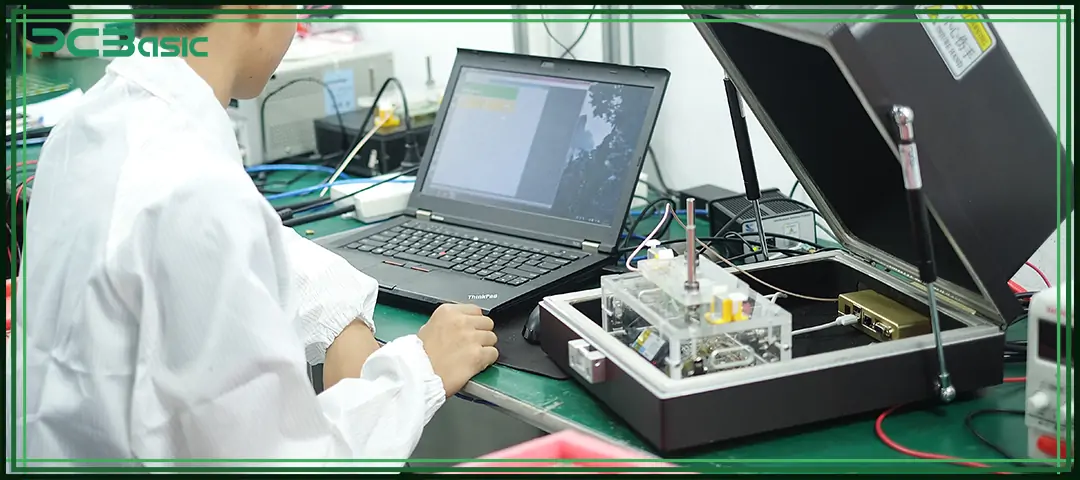
A high-quality PCBA test fixture not only needs to have a reliable mechanical structure and stable electrical performance, but also must be capable of seamless integration with the PCBA testers and test software. Only in this way can the efficiency and accuracy of the entire PCBA testing process be guaranteed.
In the PCBA testing line, the integration methods of test fixtures and systems usually include:
• Connect to the automated test equipment (ATE) to achieve full automation of the test process and reduce manual intervention.
• In the same PCBA test fixture design, both ICT and FCT are supported simultaneously, saving space and switching time.
• It supports multiple testing and configuration functions such as boundary scan, firmware programming and calibration to meet the testing requirements of different products.
• The modular PCBA test fixture kits are adopted to facilitate quick switching between different models of products and reduce fixture replacement time.
In addition, the functional test fixture can also be extended to connect to external test devices such as oscilloscopes, multimeters, and communication analyzers, to collect more comprehensive signal data and conduct advanced diagnostic analysis, helping engineers quickly locate and solve complex circuit problems.
When conducting PCBA test fixture design, we need to comprehensively consider multiple factors such as the test fixture’s structure, function and production environment to ensure its stability, efficiency and durability during PCBA testing. Therefore, when designing PCBA test fixtures, we need to pay attention to the following aspects:
When designing the probe position, tall components or areas prone to damage should be avoided to prevent device damage or impact on test stability during pressing. At the same time, the distribution of test points and the wiring layout should be taken into consideration to ensure smooth contact.
Select pogo pins with a rated number of cycles that match the expected lifespan to ensure stable contact performance during long-term use in mass production and avoid misjudgment caused by poor contact.
For PCBs with sensitive components, reliable grounding and shielding measures should be integrated in the fixture to effectively prevent electrostatic discharge from damaging components, especially in a dry production environment. This point should be given more attention.
When designing, the cleaning and replacement operations of the probe tip should be taken into account to ensure that the maintenance work is simple and fast, reduce downtime, and thereby increase the utilization rate of the entire production line.
Reasonably plan the number and position of the pins, and cover all key test points as much as possible to ensure the comprehensiveness and accuracy of fault detection, thereby improving the yield of finished products.
As the core equipment for PCBA testing, PCBA test fixtures are indispensable both in the R&D and mass production stages. Whether it is a functional test fixture, an ICT circuit board test fixture, or a custom test fixture, as long as the appropriate choice is made, all can enhance product quality and production efficiency.
For manufacturers that need to use PCBA test fixtures or PCBA test fixture kits, they should focus on precision, durability and adaptability. An excellent set of fixtures can not only accelerate the pace of the PCBA testing but also ensure the reliability of the test results, reduce the defect rate, and cooperate efficiently with the PCBA tester.
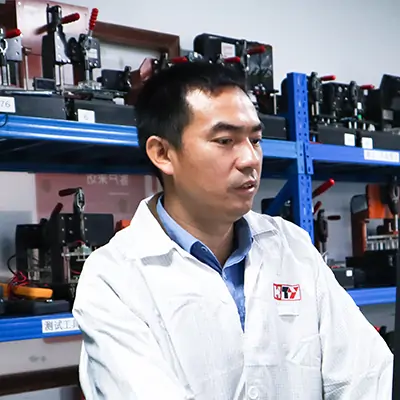
Assembly Enquiry
Instant Quote
Phone contact

+86-755-27218592
In addition, we've prepared a Help Center. We recommend checking it before reaching out, as your question and its answer may already be clearly explained there.
Wechat Support

In addition, we've prepared a Help Center. We recommend checking it before reaching out, as your question and its answer may already be clearly explained there.
WhatsApp Support

In addition, we've prepared a Help Center. We recommend checking it before reaching out, as your question and its answer may already be clearly explained there.
